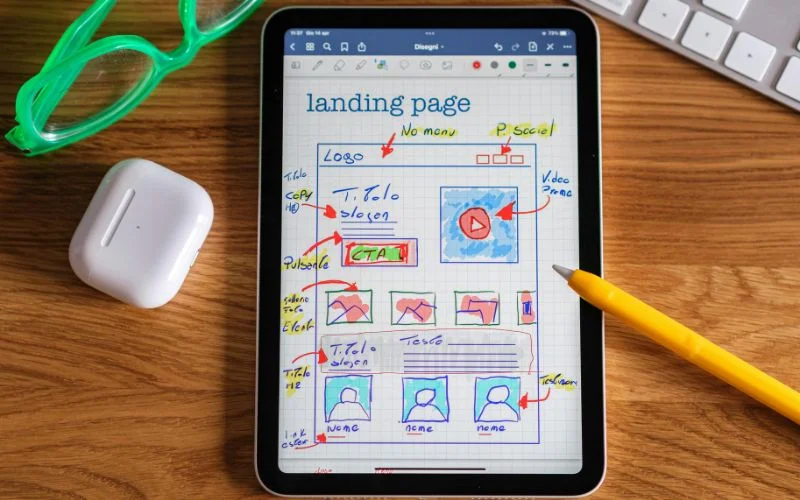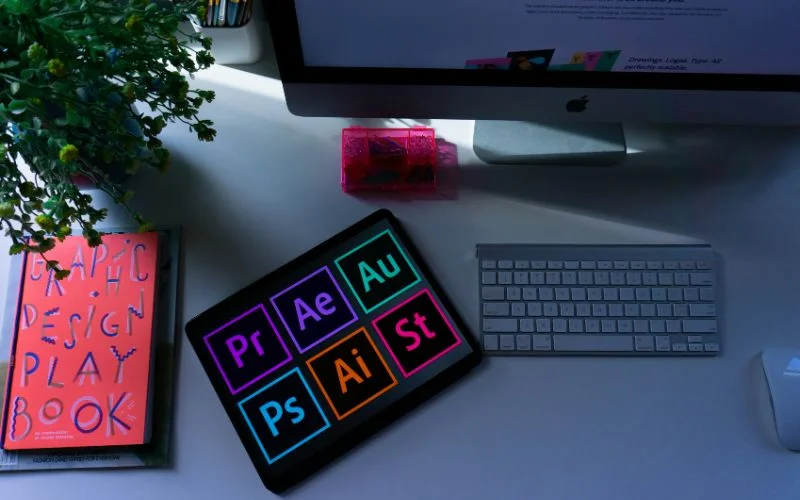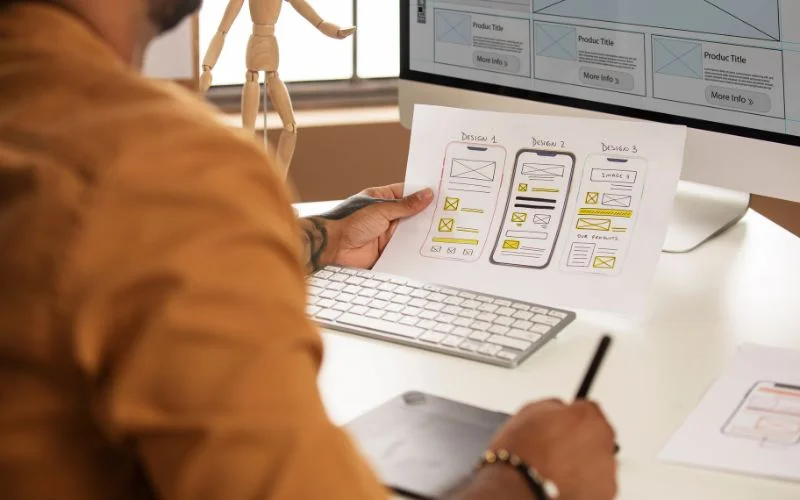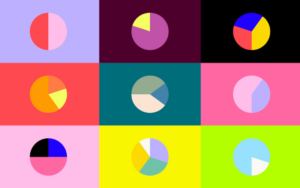If you’re looking to create a stunning and user-friendly website, you’ve probably got a million ideas swirling around in your head. But before you start coding away or picking out colors, getting a grip on the basics of web design is essential.
Let’s break down the fundamental elements to help you create a beautiful, user-friendly website. Whether you’re a newbie or have some experience under your belt, this guide will help you master the web design basics. Ready? Let’s get started!
Table of contents
Understanding Fundamentals Of Web Design
Purpose And Goals

Before you even think about colors and fonts, you need to know why you’re building your website. This is one of the most crucial web design basics. Is it a blog or an online store, or are you creating a portfolio?
Each type of website has different goals, and knowing yours will guide your design decisions. For example, an e-commerce site needs a straightforward path to purchase, while a portfolio site should showcase your best work front and centre. Defining your purpose helps set the foundation for everything else.
Explore our top picks for mastering the essentials of web design:
- Most Popular Recent Trends In Web Design
- The Difference Between Web Designer And Developer
- Parallax Effect In Web Design – The Rise And Fall Of This Trend
- Importance Of Wireframes In Web Design And Why You Should Use Them
- Non-Profit Website Design – How To Get Them Right
- Single Page Website Design – Guidelines And Ideas
- Simplify Your Website Design Using These Steps
- How You Should Design Web Forms
- How To Achieve Visual Hierarchy In Web Design
- How To Create A Good FAQ Page?
Target Audience

Who are you designing for? Understanding your audience is crucial and is another core aspect of web design basics. Are they tech-savvy millennials or retirees looking for gardening tips? Knowing your audience helps you make design choices that appeal to them.
Do some research – look at what your competitors are doing, survey potential users, and get to know your audience’s preferences and pain points. Tailoring your design to your audience can significantly enhance user satisfaction.
Also read: How To Design For Wearable Devices
Key Elements Of Web Design
Layout And Structure

A clean and organized layout is the backbone of good web design. Think of your website as a well-organized room – everything should have its place. This principle is one of the web design basics that can’t be overstated.
There are different types of layouts, such as grid, asymmetrical, and single-page. Choose one that best fits your content. Remember, simplicity is key. A cluttered website can overwhelm visitors and drive them away.
Color And Typography

Color sets the mood of your site. Choosing a suitable colour scheme is a fundamental part of web design. Select colors that reflect your brand and are visually appealing. Typography is equally important – it affects readability and the overall feel of your site. Pick fonts that are easy to read and pair them well.
For example, a bold header and clean, simple body font can look great together. Your choices in color and typography can make a big difference in how users perceive your site.
Get the full picture of web design through our curated blog selection:
- Generate More Leads With A High Converting Landing Page
- Credit Card Payment Forms: The Ultimate Design Guide
- How To Create Intuitive Web Design Interfaces
- How To Design A Restaurant Website
- What Is The Future Of Web Design
- How To Design Website Footers
- Color Trends In Web Design
- What Are The Different Web Design Patterns?
- The Secrets Of Color Filters In Web Design
- Should You Use Self-Hosted Or Embedded Videos?
Imagery And Graphics

Images and graphics can make or break your website. High-quality visuals grab attention and convey messages quickly. Make sure your images are relevant and optimized for fast loading.
And don’t forget about responsive website basics—your images should look great on all devices, from desktops to smartphones. Visuals that enhance your content without slowing down your site contribute to a better user experience.
Also read: How To Design Business Web Apps
Enhancing User Experience (UX)
Website Design Fundamentals Regarding Navigation

Good navigation is like a well-marked trail – it helps users find what they’re looking for without getting lost. Effective navigation is a critical part of web design basics. Use clear labels for your menu items and keep it simple.
Too many options can be confusing. Stick to standard placements like a top or side menu for easy access. Streamlined navigation helps users find information quickly and efficiently.
Loading Speed

Nobody likes waiting, especially online. A slow-loading site can frustrate users and hurt your search engine rankings. Speed optimization is another vital aspect of web design basics. Optimize your images, leverage browser caching, and consider using a content delivery network (CDN) to speed up your website.
Many tools like Google PageSpeed Insights can help you test and improve your site’s performance. A fast website keeps users engaged and reduces bounce rates.
Enhance your web design knowledge with our carefully selected blogs:
- All You Need To Know About The Hamburger Menu Icon
- How To Design Websites That Are Accessible By The Disabled
- The Trend Of Long Scrolling Websites
- What Are Pastel Colors?
- The Rise Of Split Screen Web Design Trend
- What You Must Do Designing A Travel Website
- Best Tips For Designing Websites For Tablets
- How To Use Large Background Images In Web Design
- What You Should Know About Designing a Navigation Bar
- Here’s What You Need to Do to Make Your Website Look Better
Mobile Responsive Web Design Fundamentals

More people are browsing the web on their phones than ever before, so having a mobile-friendly design is crucial. Mobile responsiveness is a cornerstone of modern web design basics.
Ensure your site adapts to screen sizes and functions well on all devices. Test your site on various devices to ensure a smooth experience for all users. A mobile-friendly site improves user experience and boosts your search engine rankings.
Also read: How To Create A Great Dark Website Design
Tools and Resources
Design Tools

There are some fantastic tools out there that make web design easier. Adobe XD, Figma, and Sketch are popular choices among designers. These tools offer powerful features to help you create prototypes, collaborate with others, and bring your designs to life.
Familiarizing yourself with these tools is part of mastering web design basics. They streamline the design process and enhance your creativity.
Learning Resources For Web Design Basics

Plenty of resources are available if you’re eager to learn more about web design. Websites like Coursera, Udemy, and LinkedIn Learning offer courses on web design basics. Don’t forget about blogs and tutorials – they’re great for picking up new tips and staying updated on trends.
Some books worth checking include “Don’t Make Me Think” by Steve Krug and “HTML and CSS: Design and Build Websites” by Jon Duckett. Continuous learning helps you stay current with web design trends and best practices.
Discover our favorite blogs to gain a complete grasp of web design:
- Learn How To Use Images On Your Website
- The Ultimate Guide To Flat Design
- Why You Should Follow Website Trends With Caution
- How To Use White Space In Design
- How Can You Customize Your Checkout Page Design
- How To Create A Brand With Web Design
- How To Design For Different Age Groups
- How To Create A Good-Looking Website Design
- Using Psychology To Get The Desired Results From Your Websites
- How To Design Good Original Websites
Wrapping Up
Web design is an exciting field where creativity meets functionality. By understanding the basics, you’ll be well on your way to creating beautiful and user-friendly sites. Remember to keep in mind your purpose and audience, pay attention to layout and visual elements, and always aim for a great user experience.
Mastering these basics will set you up for success in your web design journey.
Like this post? Check out more fantastic web design content here.





